What is a modern Pagan Halloween? Let’s take a deeper look at the origins of Samhain, Halloween and it’s effects on the modern Pagan community.
Halloween, that whimsically eerie and candy-filled holiday, conjures images of jack-o’-lanterns, spooky costumes, and ghostly tales. Yet, beneath the surface of this widely recognized celebration lies a tapestry woven with ancient traditions, spiritual beliefs, and a deep connection to the natural world. The modern Pagan Halloween is not much different today than it was hundreds of years ago.
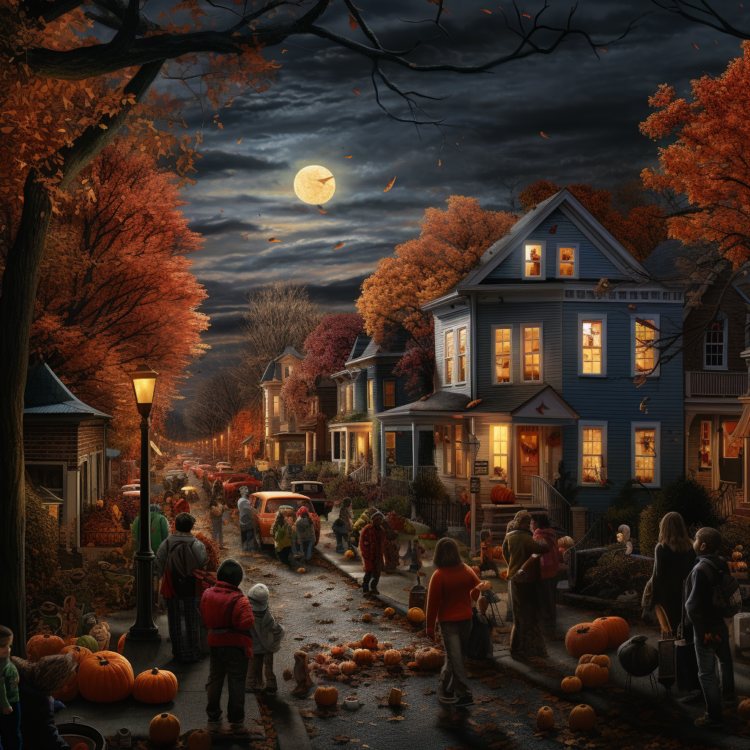
Nowhere is this intricate interplay more evident than within the modern pagan community. Beyond the commercialized façade, Halloween stands as a pivotal moment for modern pagans to honor their roots, connect with the spiritual realm, and embrace the profound essence of life’s cyclical nature.
Throughout history, Halloween has undergone a metamorphosis, evolving from its origins in ancient Celtic festivals into a multifaceted occasion that bridges cultures, beliefs, and generations.
In the modern pagan context, Halloween serves as a bridge between worlds, a time when the barriers separating the physical and spiritual realms become porous, allowing for communion with ancestors and spirits.
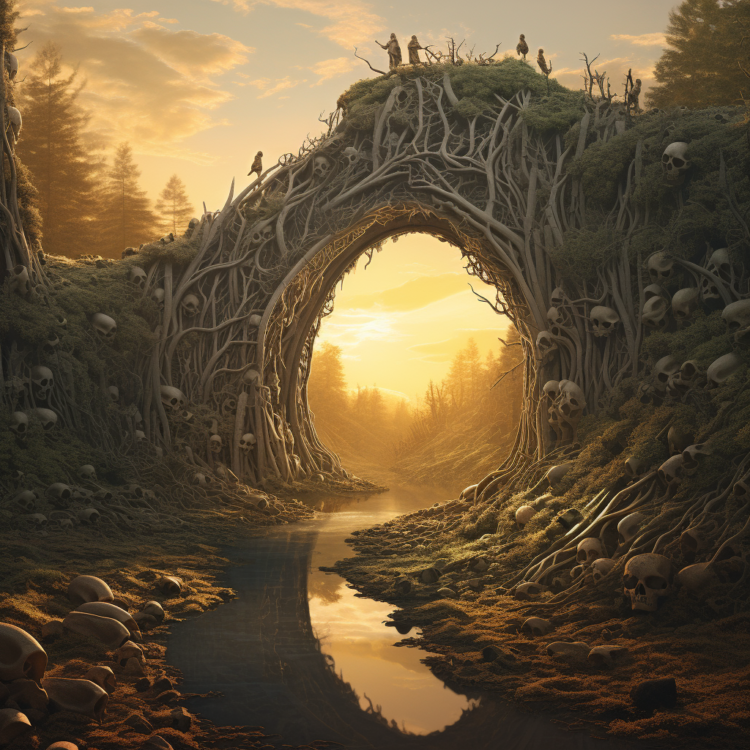
This perspective imbues Halloween with a depth of significance that echoes the essence of modern pagan beliefs, which often revolve around nature worship, ancient deities, and the sacred interconnectedness of all things.
This exploration into Halloween’s meaning within the modern pagan community invites us to venture beyond the surface-level spookiness and delve into the rich history, beliefs, and practices that give this holiday a unique resonance.
By understanding the deep-rooted connections to ancient traditions, the evolving nature of celebrations, and the profound rituals that mark this time, we can unveil the layers of spirituality and wisdom that enrich the experience of Halloween for modern pagans.
As we journey through the pages of this blog post, we will unveil the tapestry that binds Halloween to the modern pagan heart, revealing a celebration that is not just about the harvest and the macabre, but a celebration that beckons us to embrace the mysteries of existence itself.
Halloween’s Ancient Roots in Pagan Traditions:
Halloween’s story begins in the heart of ancient Celtic lands, where the festival of Samhain marked the end of the harvest season and the onset of winter’s darkness.
Samhain, pronounced “sow-in,” held a central place in Celtic culture, serving as a time of profound significance that transcended the boundary between the living and the spirit world.
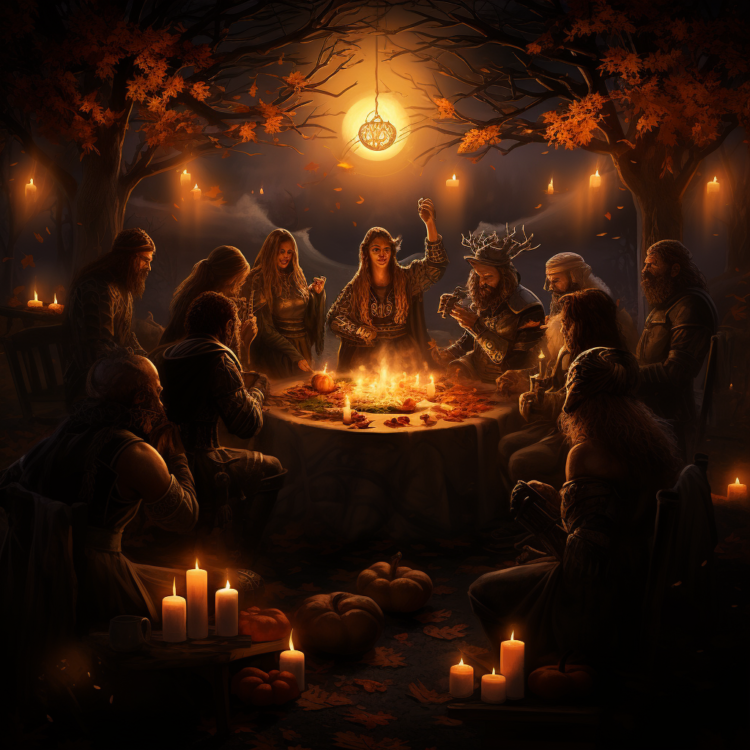
Samhain wasn’t just a festival; it was a liminal space, a threshold between the waning warmth of summer and the encroaching chill of winter. The Celts believed that during this juncture, the veil separating the world of the living from that of the deceased was at its thinnest.
This thinning of the veil was not a cause for fear, but rather an opportunity for communion – a time when the spirits of ancestors and otherworldly beings could pass freely between realms and interact with the living.
The celebration of Samhain was a vibrant tapestry of rituals and practices. Huge bonfires blazed to ward off the encroaching darkness and to honor the Celtic deities.
People would don costumes made from animal hides and masks, believing that this transformative act allowed them to disguise themselves from wandering spirits or to embody the spirits themselves.
Food offerings were laid out to placate and welcome the visiting spirits, and hearth fires were relit from the sacred bonfires to symbolize renewal and protection.
In the modern pagan context, Halloween’s ancient roots in Samhain resonate deeply. Modern pagans view this time as a portal, not only to honor ancestors and loved ones who have passed, but also to tap into the liminal energy of transformation.
Samhain’s symbolism echoes through the years, reminding pagans of the interconnectedness of all life and the cyclical nature of existence.
By embracing the spirit of Samhain, modern pagans continue a tradition that has traversed centuries – a tradition that weaves the threads of history, reverence for nature, and a profound respect for the mysteries of life and death.
Halloween’s Evolution through History:
With the advent of Christianity, the ancient Celtic traditions were integrated into All Saints’ Day and All Souls’ Day. These Christian observances were strategically placed to coincide with Samhain, creating a complex interplay between pagan customs and Christian practices.
Halloween, as we know it today, is a blend of these ancient pagan roots and Christian influences, demonstrating the adaptability of cultural traditions over time.
As history unfolded and cultures intersected, the evolution of Halloween took on a dynamic and complex character. With the spread of Christianity, the merging of ancient pagan traditions with Christian observances transformed the nature of the holiday.
The early Christian Church sought to replace or assimilate existing pagan festivals and practices to make the transition to Christianity more seamless for newly converted populations.
In this effort, the dates of All Saints’ Day (November 1st) and All Souls’ Day (November 2nd) were strategically placed to coincide with the pagan festival of Samhain.
All Saints’ Day was dedicated to honoring saints and martyrs, while All Souls’ Day focused on praying for the souls of the deceased.
This integration of Christian beliefs into the framework of pagan festivities brought about a syncretism that was both intentional and unintentional.
The bonfires of Samhain transformed into the “soul lights” of All Saints’ Day, and the practice of “souling” (going door to door for food or offerings) began to resemble modern trick-or-treating.
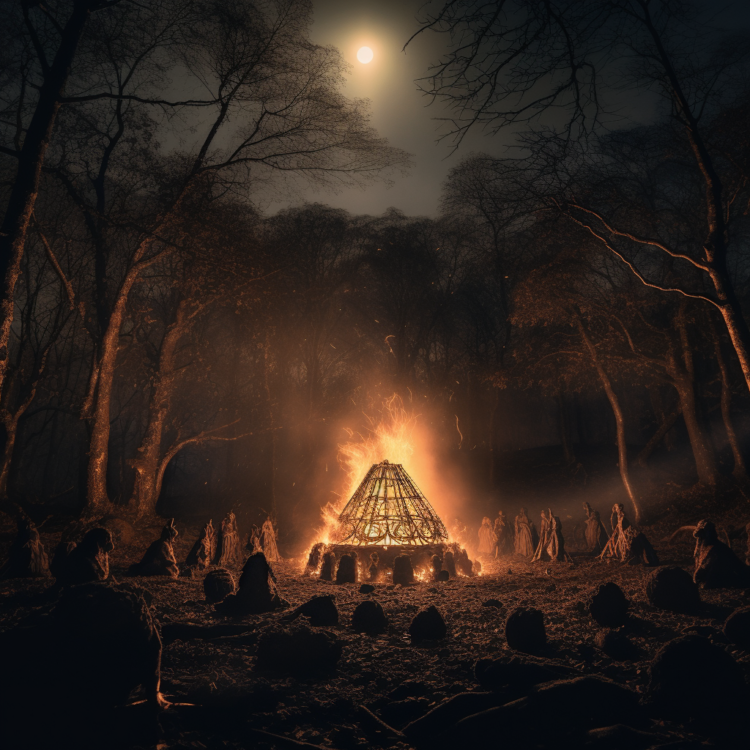
The notion of appeasing spirits through offerings transitioned to prayers for souls in purgatory.
As centuries passed, Halloween in its various forms journeyed across continents, adapting to the cultural nuances of different societies.
In North America, it mingled with the traditions of immigrants, giving rise to the distinctly American concept of Halloween we know today – a blend of Irish and Scottish practices with Native American influences and colonial American customs.
In the modern pagan community, this complex evolution highlights the resilience of ancient beliefs in the face of change. Halloween is seen as a tapestry woven with the threads of history, carrying echoes of multiple cultures and spiritual perspectives.
The modern pagan’s celebration of Halloween reflects a conscious embrace of this rich tapestry, acknowledging both the ancient roots and the ever-changing layers that history has added to this multi-faceted holiday. Through their observances, modern pagans pay homage to the ancestors who paved the way and the diverse beliefs that have converged to create the modern Halloween experience.
Modern Pagan Practices and Beliefs:
In the heart of the modern pagan community, Halloween takes on a special significance that aligns with their diverse range of beliefs and practices.
Modern paganism encompasses a wide spectrum of traditions, including Wicca, Druidry, Heathenry, and eclectic spiritual paths. While each tradition has its unique approach, there are common threads that weave their way through modern pagan observances of Halloween.
For modern pagans, Halloween is more than just a seasonal celebration; it’s a time of deep spiritual connection to the rhythms of nature and the cycles of life and death.
Many pagans view Halloween as a liminal period, mirroring the liminality of their own spiritual journey. Just as the world transitions from the vibrancy of autumn to the stillness of winter, so too do pagans navigate the cycles of growth, introspection, and transformation in their personal lives.
During Halloween, modern pagans often engage in rituals and ceremonies that reflect their reverence for the interconnectedness of all things. The emphasis on the thinning of the veil between worlds aligns with their belief in the accessibility of the spirit realm during this time.
Rituals may involve setting up elaborate altars adorned with symbols, photographs, and offerings for ancestors and spirit guides. Through these altars, modern pagans seek to establish a sacred space for communication and communion with those who have passed on.
Divination, a practice deeply rooted in pagan traditions, takes on heightened significance during Halloween.
Tarot readings, scrying with mirrors or crystals, and other forms of divination are believed to be particularly potent when performed during this liminal period. The modern pagan’s connection to nature also extends to their divinatory practices, as they look to the elements and natural signs for insights into the future.
Beyond rituals, Halloween is a time for storytelling and myth-making. Modern pagans often gather to share stories of their deities and ancestors, weaving a tapestry of wisdom and connection.
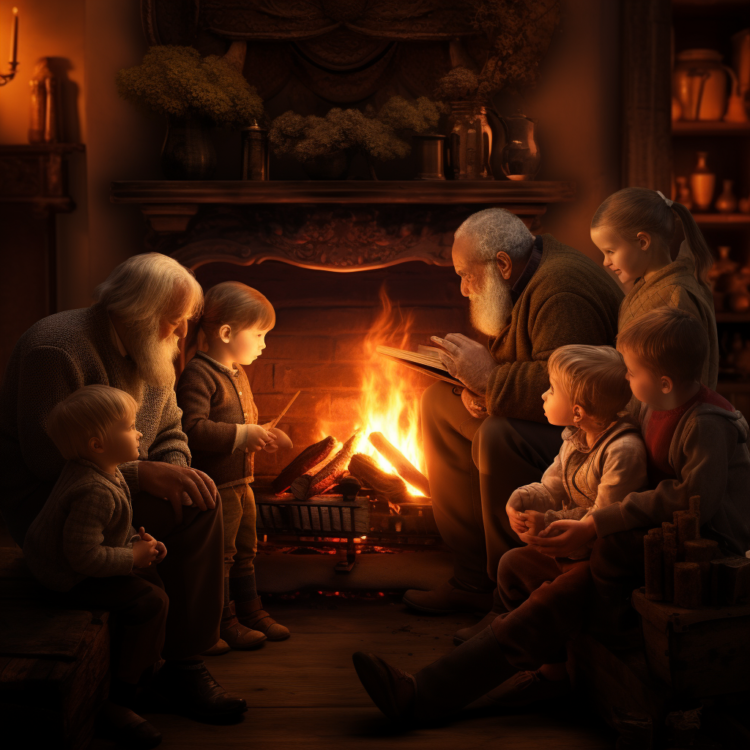
These stories serve as a way to honor the past, understand the present, and imagine the future – a practice deeply ingrained in pagan cultures throughout history.
Ultimately, Halloween holds a mirror to the diverse beliefs within the modern pagan community.
It’s a time when the sacred and the mundane intertwine, offering modern pagans a moment to honor their spiritual journey, connect with the spirits that walk alongside them, and reaffirm their commitment to the cycles of nature.
Through their practices and beliefs, modern pagans weave the ancient threads of Samhain into the rich fabric of their contemporary lives, creating a tapestry that is both unique and deeply rooted in the past.
Halloween as a Time for Spiritual Connection:
Within the modern pagan community, Halloween stands as a bridge between the realms of the seen and the unseen, a portal to the mysterious and the spiritual.
This liminal time, when the veil between worlds is said to be thinnest, holds a profound significance for modern pagans seeking to connect with the spirit realm, commune with ancestors, and gain insights from the beyond.
Central to the concept of Halloween’s spiritual connection is the idea of liminality – a state of in-betweenness, where the usual boundaries blur and possibilities become endless.
Modern pagans believe that during this period, the barriers separating the living and the spirit world become permeable, allowing for easier communication and interaction.
One of the cornerstones of modern pagan Halloween celebrations is the creation of ancestor altars. These altars are adorned with photographs, objects, and offerings that hold personal significance to the individual.
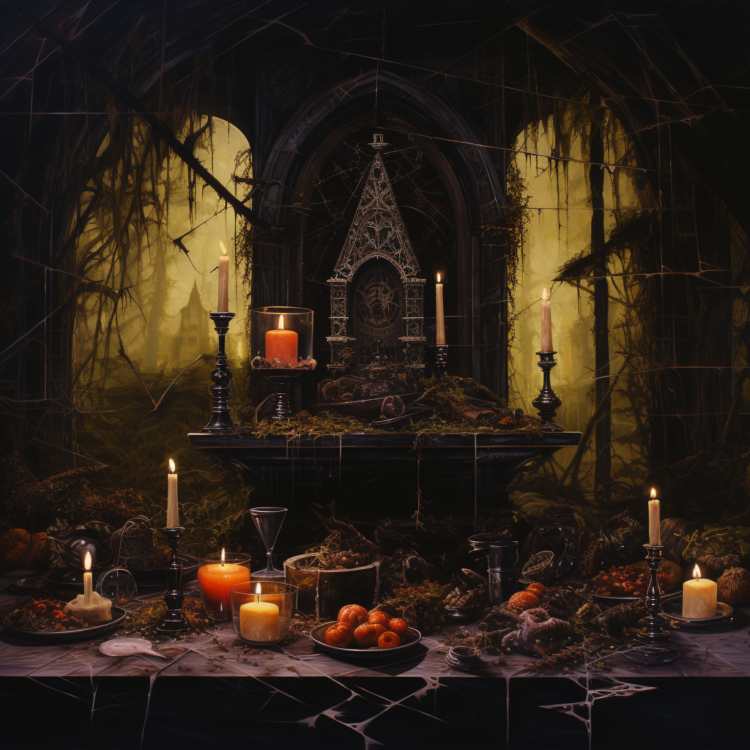
Modern pagans believe that by building this bridge between the realms and inviting their ancestors to partake in the festivities, they can seek guidance, honor familial ties, and strengthen the bond between the living and the departed.
Divination, a practice deeply embedded in pagan traditions, takes on a heightened role during Halloween. The practice of seeking insight and guidance from the spirit realm is believed to be particularly potent at this time. Tarot cards, runes, scrying tools, and other divinatory methods become channels through which modern pagans can tap into the wisdom of the unseen, receiving messages and guidance from spiritual forces.
Guided meditations and ritual ceremonies also play a significant role in Halloween’s spiritual connection.
Through meditation, individuals enter altered states of consciousness, allowing them to traverse the threshold between worlds and engage in direct communication with spirits or ancestral energies.
Rituals, often held around bonfires or sacred spaces, involve invocations, chants, and offerings that serve as a bridge to the spiritual realm.
For modern pagans, Halloween’s spiritual connection goes beyond rituals and practices. It’s a time of deep introspection and reflection. The cycles of life, death, and rebirth that are symbolized by Halloween mirror the cycles within each individual’s life.
Through this connection, modern pagans find solace in the impermanence of existence and the assurance that life and transformation are eternal.
As modern pagans engage in these practices, they embrace the energy of Halloween as an opportunity for profound personal growth, heightened awareness, and a strengthened bond with the spiritual forces that shape their journey.
Through these acts of connection, modern pagans breathe life into the ancient traditions, imbuing Halloween with a sense of reverence, meaning, and the enchantment of the unknown.
Rituals and Traditions within the Modern Pagan Community:
In the modern pagan community, Halloween is a time of active engagement with ancient rituals and innovative practices that serve to honor the spirit of the season, connect with ancestors, and explore the mysteries of the unseen realms.
This section unveils the tapestry of rituals and traditions that modern pagans weave during this enchanting time.
Ancestor Altars and Offerings:
Ancestor altars stand as the beating heart of modern pagan Halloween celebrations, embodying the ancient wisdom that life is an unbroken thread connecting the past, present, and future.
These altars are a tangible bridge between the worlds, a place where modern pagans pay homage to those who came before, seeking guidance, wisdom, and a continuation of familial bonds.
Creating the Sacred Space: Ancestor altars are often set up in a quiet and contemplative space within the home. A table or designated area is transformed into a sacred space adorned with symbolic items. A richly colored cloth, often in autumnal hues, serves as the foundation. Items such as photographs of ancestors, family heirlooms, candles, incense, and natural elements like leaves or stones are thoughtfully arranged to create a meaningful and evocative environment.
Inviting the Ancestors: The process of setting up the ancestor altar is a deliberate act of inviting the spirits of departed loved ones to join the living in celebration. It’s a reflection of the belief that the veil between realms is at its thinnest during Halloween, allowing for easier communication. The altar becomes a conduit, a space where modern pagans can share stories, express gratitude, and establish a sense of connection with their lineage.
Offerings and Nourishment: Offerings play a central role in ancestor veneration. Traditional foods, drinks, and items that held significance in the lives of ancestors are placed on the altar as a way of nourishing their spirits and showing respect. These offerings symbolize a reciprocal relationship, a gesture of appreciation for the wisdom and experiences passed down through generations. Modern pagans may also offer symbols of their own life experiences as a form of connection.
Communication and Reflection: The ancestor altar becomes a place of communion, where modern pagans engage in private conversations with their ancestors. These conversations may involve seeking guidance, asking for protection, or simply sharing the happenings of one’s life. It’s a moment of reflection and connection, a time when the living can gain insights and understanding from those who have journeyed before them.
Personalized Touch: Every ancestor altar is unique, reflecting the individual’s relationship with their lineage. Some altars are adorned with items of cultural significance, honoring ancestral traditions and practices. Others may focus on specific family members or figures of historical or spiritual importance. The altar’s arrangement is a reflection of the modern pagan’s personal journey, beliefs, and the stories that have shaped their identity.
The Legacy of Connection: Ancestor altars and offerings, at their core, embody the timeless belief that the spirit of family endures beyond physical existence. Through these practices, modern pagans weave a sense of continuity, acknowledging that the wisdom, love, and experiences of ancestors continue to guide and shape their lives. Ancestor altars serve as a space of remembrance, gratitude, and celebration, bridging the gap between the seen and unseen with reverence and devotion.
Divination and Spirit Communication:
In the mystical tapestry of modern pagan Halloween celebrations, divination and spirit communication threads their way as potent practices that offer glimpses into the unseen realms, forging connections with ancestral wisdom and cosmic energies.
These practices evoke the ancient traditions of seeking guidance from beyond, breathing life into the spiritual essence of the season.
Tools of Divination: Divination, the art of gaining insights from the unseen through various tools and methods, takes on an aura of heightened significance during Halloween.
Tarot cards, with their rich symbolism and archetypal imagery, are often sought after for readings that offer guidance and perspective.
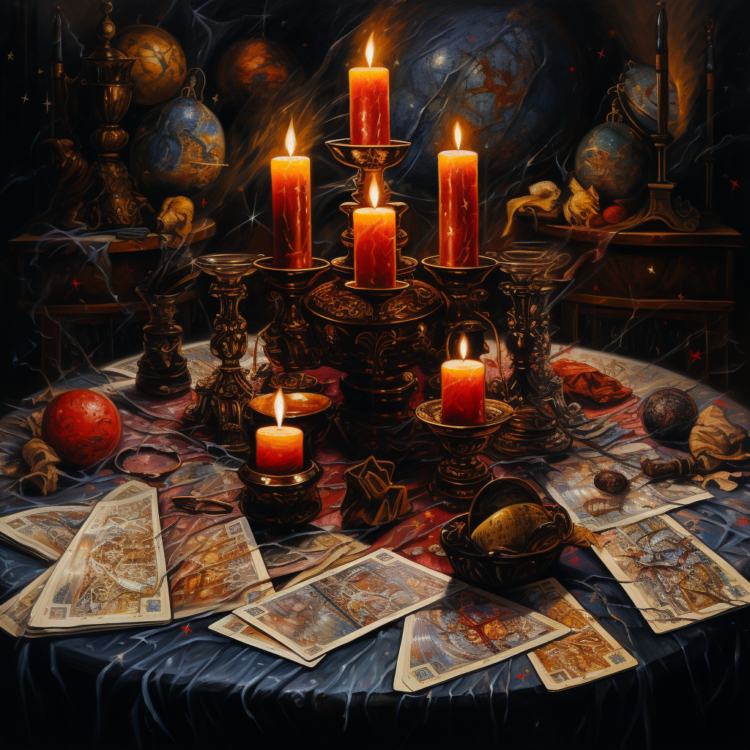
Runes, ancient symbols carved into stones or tiles, tap into Norse traditions, offering glimpses into the threads of destiny.
Scrying, gazing into mirrors, water, or crystal balls, becomes a portal for intuitive visions that transcend the mundane.
Channeling the Veil’s Energy: Halloween’s thinning veil between worlds is believed to amplify the effectiveness of divination. The energy of the season is seen as a bridge, facilitating communication between the living and the spirit realm. Modern pagans engage in divination with the intention of gaining insights from ancestors, spirit guides, or deities who are believed to be more accessible during this liminal time.
Ancestral Insights: Divination serves as a conduit for connecting with ancestors, seeking their guidance and wisdom. As modern pagans engage in divination sessions, they often focus on questions related to their personal journey, seeking insights into challenges, opportunities, and the path ahead.
The act of divination becomes a dialogue with the spirits of the past, as practitioners channel their energies to interpret symbols and messages.
Group Divination: During Halloween, divination often extends to group settings, where modern pagans gather to collectively seek guidance. Group divination not only strengthens the communal bond but also enhances the energy of the session, creating a shared experience that invokes a sense of unity and connectivity with the unseen.
Ritualistic Approach: Modern pagans approach divination as a sacred ritual. Before engaging in a session, they may cast a protective circle, invoke the presence of ancestral spirits, and set their intentions.
The act of divination is a form of communication, an invitation for wisdom and insight to flow from the spiritual realm to the material world.
Interpreting Symbols: The heart of divination lies in the interpretation of symbols, patterns, and messages received through the chosen medium. Modern pagans draw upon their intuitive faculties, knowledge of symbolism, and their personal connection to the spiritual realm to decode the messages.
The interpretations often go beyond the literal, delving into the layers of meaning and resonance within the symbols.
Embracing the Unseen: Divination and spirit communication during Halloween embody the modern pagan’s embrace of the mysteries of existence.
By seeking guidance from the unseen, they honor the interconnectedness of all things, acknowledging that the spiritual realm is an integral part of their journey.
Through these practices, modern pagans weave the past, present, and future into a tapestry of insight and inspiration, allowing the energy of Halloween to awaken their intuition and forge connections with realms beyond the physical.
Guided Meditations and Séances:
In the realm of modern pagan Halloween celebrations, guided meditations and séances emerge as poignant practices that delve into the depths of consciousness, inviting participants to explore the mysteries of the unseen and to communicate with spirits.

These practices are like keys to unlock the doors between realms, offering modern pagans a chance to embark on transformative journeys and intimate conversations.
Guided Meditations as Spiritual Journeys: Guided meditations during Halloween are akin to spiritual journeys. Modern pagans enter altered states of consciousness, often led by a facilitator or through recorded audio, to traverse the boundaries of the physical world and venture into the ethereal.
These journeys might involve walking through ancestral landscapes, crossing a symbolic threshold, or encountering spirit guides who offer wisdom and guidance.
Connecting with Ancestral Energies: Halloween’s thinning veil is believed to enhance the potency of guided meditations, making it easier for participants to connect with ancestral energies.
Through visualization and intention, modern pagans may meet with departed loved ones, engage in conversations, or gain insights into their own lineage. This practice fosters a sense of continuity, as participants feel the presence of their ancestors as an integral part of their journey.
Séances as Spirit Conversations: Séances, gatherings specifically designed to communicate with spirits, take on a deeper dimension during Halloween. Modern pagans approach séances with respect and caution, creating a sacred space that invites spirits to join the gathering.
Participants often sit in a circle, creating a sense of unity and protection, and may use tools like pendulums or spirit boards to facilitate communication.
Setting Intentions: Whether engaging in guided meditations or séances, modern pagans begin with a clear intention. This intention might involve seeking guidance, connecting with specific ancestors, or gaining insight into personal challenges.
The intention sets the stage for a focused and meaningful experience, directing energy toward the desired connection.
Creating Safe Spaces: Both guided meditations and séances require a safe and respectful environment. Before embarking on a meditation journey or initiating a séance, modern pagans cast a protective circle.
This circle acts as a boundary that prevents unwanted energies from entering and ensures that the energies raised during the practice are contained within the space.
Respectful Dialogue: During séances, participants engage in a respectful dialogue with spirits. Questions may be asked, and responses might be received through various means, such as pendulum movements or verbal messages through a medium.
The focus is on creating a space of openness and reverence, where the spirits’ wisdom and messages can be heard and honored.
Transformation and Healing: Guided meditations and séances offer opportunities for transformation and healing. Participants often report profound insights, emotional releases, and a deep sense of connection with the unseen.
Through these practices, modern pagans not only gain insights into the mysteries of the spirit realm but also experience personal growth and healing on a profound level.
Guided meditations and séances during Halloween exemplify the modern pagan’s courage to explore the unknown and their dedication to forging connections with the unseen world.
By engaging in these practices, modern pagans weave a tapestry of connection, insight, and transformation, allowing the energy of Halloween to open doors to realms beyond, where spirits and wisdom await to be discovered.
Rituals and Ceremonies:
In the enchanted realm of modern pagan Halloween celebrations, rituals and ceremonies emerge as sacred acts that honor the seasonal energies, invoke the spirits, and deepen the connection to the unseen.
These rituals are woven with intention, symbolism, and a sense of reverence, allowing modern pagans to engage with the spiritual essence of the season in profound and transformative ways.
Casting Sacred Circles: Many modern pagan rituals begin with the casting of a sacred circle. This act creates a boundary that separates the mundane world from the sacred space where the ritual unfolds. The circle acts as a vessel to contain and amplify energy, allowing participants to focus their intention and connect more deeply with the spiritual realm during Halloween.
Invoking Ancestral Presence: Halloween’s significance as a time of communion with ancestors is often central to modern pagan rituals. Invocations are made to invite the spirits of departed loved ones, ancestors, and guiding spirits to join the circle. Through words, chants, and symbols, participants seek to establish a sense of connection and unity.
Bonfires and Sacred Fires: The symbolism of fire holds deep meaning within modern pagan rituals. Bonfires are often kindled as an embodiment of transformation, illumination, and protection. The flames are seen as a beacon that attracts and guides spirits, making it easier for participants to communicate with the unseen.
Guided Meditation and Pathworking: Rituals often incorporate guided meditation or pathworking – a form of interactive meditation where participants visualize and explore specific landscapes or scenarios. Modern pagans might journey to an otherworldly realm, meet with ancestral spirits, or experience symbolic transformations. Guided by a ritual leader or facilitated by recorded audio, pathworking adds a dynamic dimension to the ritual experience.
Offerings and Symbolism: Offerings of food, drink, herbs, and symbolic items are placed on altars or within the ritual circle as tokens of gratitude and respect to the spirits. These offerings are believed to nourish and honor the unseen guests and create a sense of reciprocity. Symbolic actions, such as lighting candles or pouring libations, hold meaning that transcends the material realm.
Chants and Incantations: Chants, incantations, and spoken words are woven into modern pagan rituals to amplify intention and raise energy. These vocalizations are believed to resonate with the spiritual energies and connect participants with the rhythms of the universe. The repetitive nature of chants fosters a trance-like state, enhancing the connection to the spiritual realm.
Closing the Circle: At the conclusion of a ritual, the circle is ceremoniously closed. This act releases the contained energy and severs the connection between the mundane and the sacred. Participants often express gratitude to the spirits, ancestors, and deities for their presence and guidance, acknowledging the shared experience.
Integration and Reflection: After a ritual, modern pagans often engage in moments of reflection, journaling, or group discussions. This phase allows participants to process their experiences, insights, and emotions that emerged during the ritual. The integration phase deepens the impact of the ritual’s energy and wisdom.
Transformative Connection: Rituals and ceremonies during Halloween empower modern pagans to forge transformative connections with the unseen. By aligning their intentions, actions, and symbolism with the energy of the season, participants navigate the threshold between worlds, engaging with ancient wisdom, ancestral spirits, and the mysteries that lie beyond the veil.
Through these sacred acts, modern pagans weave their own stories into the tapestry of the spiritual landscape, embodying the profound essence of Halloween.
Community Gatherings and Festivals:
Within the vibrant fabric of modern pagan Halloween celebrations, community gatherings and festivals stand as dynamic expressions of unity, shared wisdom, and collective celebration. These gatherings offer modern pagans a platform to connect, exchange knowledge, and immerse themselves in a shared atmosphere of reverence and merriment.
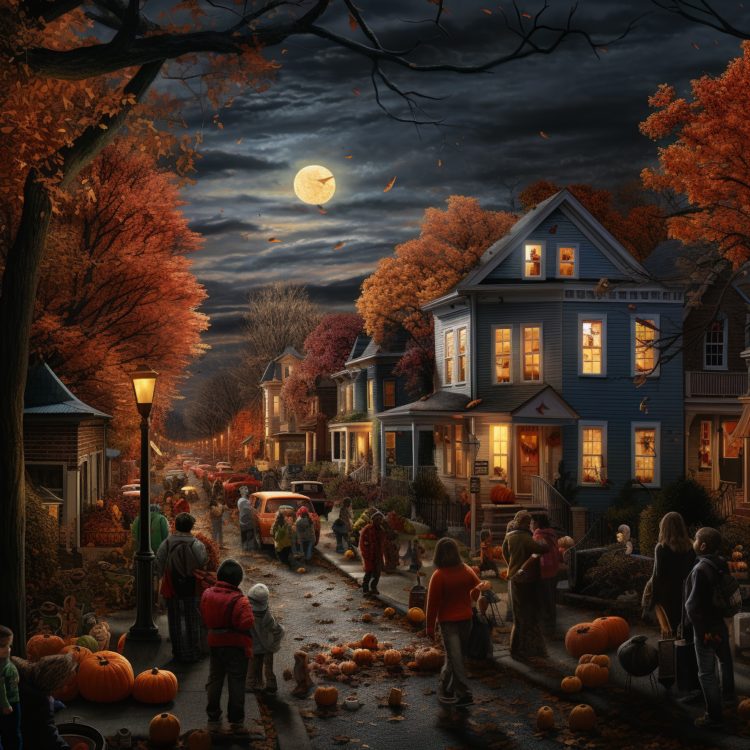
Unity in Diversity: Modern pagan community gatherings during Halloween bring together individuals from diverse traditions, paths, and backgrounds. These gatherings reflect the inclusive nature of modern paganism, where practitioners of Wicca, Druidry, Heathenry, and other traditions converge to celebrate their shared beliefs and values.
Shared Rituals and Practices: Community gatherings often feature rituals that blend the wisdom of various traditions. These rituals harmonize diverse practices, uniting participants under a common intention. The shared experience of rituals amplifies the energy and fosters a sense of connection, reinforcing the idea that while paths may differ, the reverence for nature and the unseen binds modern pagans together.
Storytelling and Workshops: Workshops and storytelling sessions become vehicles for the exchange of knowledge and experiences. Modern pagans share insights into their practices, offer guidance on rituals, and recount tales of encounters with ancestral spirits or deities. These stories serve to inspire, educate, and strengthen the bonds within the community.
Cultural Expression: Halloween gatherings provide a platform for cultural expression, allowing participants to infuse their unique heritage into the celebrations. Attendees might showcase traditional costumes, crafts, and practices that pay homage to their ancestral lineage, enriching the collective experience and deepening the appreciation for cultural diversity.
Seasonal Crafts and Offerings: Craft fairs and artisan markets are common features of Halloween festivals within the modern pagan community. Attendees can explore handmade items, artwork, and tools that are created with intention and imbued with spiritual energy. These offerings serve as tangible reminders of the connection between the material and spiritual worlds.
Musical and Artistic Performances: Festivals often feature musical performances, poetry readings, and artistic displays that evoke the spirit of the season. These creative expressions become avenues through which modern pagans can tap into the emotional and mystical dimensions of Halloween, invoking a sense of enchantment and wonder.
Children’s Activities: Family-friendly Halloween gatherings provide opportunities for children to participate in activities that are both fun and spiritually meaningful. Crafting, storytelling, and symbolic games create an environment where children can learn about their ancestral roots and the interconnectedness of all things.
Strengthening Bonds: Community gatherings and festivals serve as a catalyst for forming connections and friendships. Attendees share their personal experiences, insights, and challenges, fostering a sense of belonging and support within the modern pagan community. These connections extend beyond the event, enriching the year-round journey of each individual.
Renewed Sense of Purpose: Halloween gatherings infuse modern pagans with a renewed sense of purpose and connection to their path. Being surrounded by like-minded individuals who share their reverence for the unseen world and nature reaffirms their commitment to living in harmony with these principles.
In modern pagan Halloween gatherings and festivals, the essence of unity, diversity, and shared spirituality is palpable. Through these communal experiences, modern pagans celebrate the season’s energy, explore ancient traditions, and co-create a tapestry of connection that binds them together in a shared journey of discovery and celebration.
Artistic Expression and Crafts:
In the enchanting realm of modern pagan Halloween celebrations, artistic expression and crafts manifest as vibrant threads that weave together creativity, spirituality, and the magic of the season. These endeavors become potent forms of ritual, offering modern pagans a medium to infuse their intentions, energy, and reverence into tangible creations.
Sacred Crafting: Artistic expression and crafting during Halloween embody the modern pagan’s desire to imbue the material world with spiritual significance. Each crafted item becomes an extension of their connection to the unseen realms, carrying intention, symbolism, and energy that bridges the gap between the mundane and the mystical.
Symbolism and Intent: Every artistic creation is laden with symbolism that resonates with personal beliefs and spiritual values. For instance, candles adorned with specific colors might represent aspects of nature or deities. Amulets or talismans crafted with intention might serve as protective charms, guiding the wearer through the energetic shifts of the season.
Candles and Ritual Tools: Candles, with their transformative nature and symbolism of illumination, are often central to modern pagan crafts. Crafting candles with intention and colors that align with the season’s energy becomes a form of ritual itself. Ritual tools such as athames (ceremonial daggers), wands, and cauldrons are often crafted or adorned with intricate carvings and designs, enhancing their spiritual significance.
Altar Art and Decor: Artistic creations become integral components of altar displays. Paintings, sculptures, or digital art that depict deities, ancestral symbols, or the changing seasons adorn these sacred spaces. Altar decor crafted during Halloween often incorporates natural elements like leaves, acorns, and feathers, inviting the outdoors into the spiritual realm.
Costumes and Masks: The act of creating costumes and masks is a unique form of artistic expression that bridges the worlds of the seen and unseen. Modern pagans often craft costumes that embody their connection to nature, deities, or ancestral spirits. These costumes are not mere disguises, but embodiments of archetypes and energies that hold personal significance.
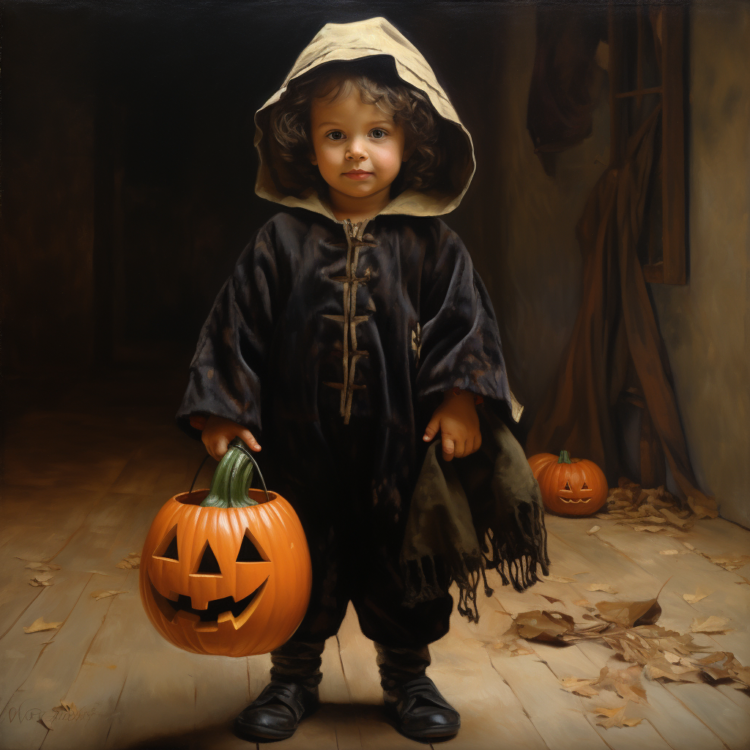
Divinatory Tools: Handmade divinatory tools, such as tarot decks, oracle cards, and runes, hold a special place in modern pagan crafting. Crafting these tools becomes an act of channeling the energy of the season and infusing the cards or stones with personal energy. The resulting tools become extensions of the modern pagan’s intuitive faculties, offering insights from the spiritual realm.
Creating Ritual Spaces: The act of setting up altars and ritual spaces during Halloween is, in itself, an artistic expression. Modern pagans carefully select items and arrange them in a visually appealing manner that aligns with their intentions. The process of arranging items on the altar becomes a meditative and purposeful act, heightening the energy of the space.
Personalized Altar Tools: Modern pagans often craft their own altar tools to imbue them with personal energy. Athames, chalices, and other tools are often selected for their materials, shapes, and symbolism. By creating these tools, practitioners infuse them with their intentions and connect more deeply with their practice.
In the tapestry of modern pagan Halloween celebrations, artistic expression and crafts are the threads that connect the spiritual with the material, the unseen with the seen.
Through these creative endeavors, modern pagans tap into the magic of the season, channeling their intentions, beliefs, and reverence into tangible forms that serve as reminders of the interconnectedness of all things.
The act of crafting becomes a sacred ritual, a celebration of the essence of Halloween and a manifestation of the modern pagan’s journey.
As modern pagans engage in these rituals and traditions, they weave the threads of the past and present into a vibrant tapestry that honors the essence of Halloween as a time of connection, transformation, and reverence.
These practices reflect the diversity within the modern pagan community, showcasing how each individual’s approach to Halloween is a unique expression of their beliefs and spiritual journey.
VI. Embracing Halloween’s Dark and Light Sides:
Halloween’s duality as a celebration of both light and shadow resonates deeply with modern pagans. They embrace the idea that confronting fears and acknowledging the darker aspects of life is essential for personal growth and transformation. This concept, known as “shadow work,” encourages individuals to explore their inner selves, address unresolved issues, and ultimately achieve a greater sense of wholeness.
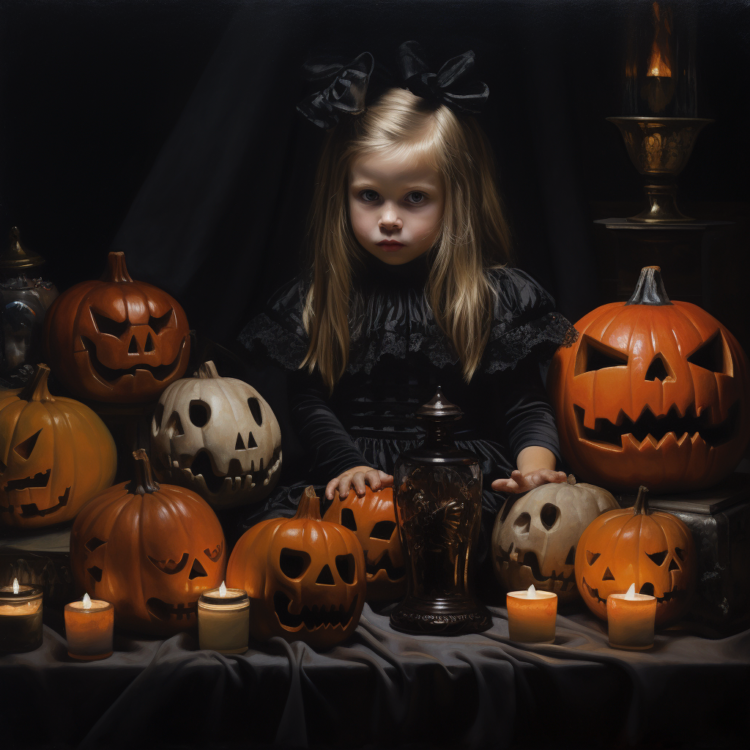
Within the modern pagan community, Halloween is a time when the duality of existence is embraced and celebrated. This duality is reflected in the interplay between light and darkness, life and death, and the seen and the unseen. Modern pagans approach Halloween as a time to honor both aspects, recognizing that darkness holds its own wisdom and lessons, just as light does.
Honoring the Dark
Shadow Work: Halloween’s association with darkness provides an opportunity for modern pagans to engage in shadow work – a process of exploring the hidden, less-acknowledged aspects of oneself. This introspective journey involves confronting fears, unresolved emotions, and aspects of the psyche that have been suppressed. By delving into the shadows, modern pagans seek healing, self-awareness, and personal growth.
Mystery and Transformation: The darkness of Halloween symbolizes the mystery and the unknown. Modern pagans see this as a time when the veil between worlds is thinnest, inviting them to engage with the mysteries of existence, transformation, and the afterlife. Embracing the darkness allows them to connect with ancestral energies, explore the depths of their intuition, and uncover hidden truths.
Respecting Death: Halloween’s connection to death is not one of fear, but of reverence. Modern pagans acknowledge death as a natural part of the cycle of life, rather than an end. The contemplation of mortality encourages a deeper appreciation for life and a recognition of the impermanence that binds all living beings.
Celebrating the Light
Harvest and Abundance: Halloween’s association with light is linked to the harvest season. Modern pagans celebrate the abundance of the Earth’s gifts, expressing gratitude for the bountiful harvest that sustains them. The symbolism of light also reflects the life-giving energy of the sun, which nourishes the land and brings forth growth.
Renewal and Rebirth: The celebration of light during Halloween extends to themes of renewal and rebirth. Just as the natural world sheds its leaves and enters a period of rest, modern pagans see this time as an opportunity for personal reflection, shedding old habits, and embracing new beginnings.
Ancestor Communion: The light of Halloween symbolizes the guidance and wisdom offered by ancestors and spiritual guides. By communing with these energies, modern pagans find illumination in the form of insights, guidance, and a renewed sense of connection to their lineage.
Balancing the Two
Modern pagans approach Halloween as a time to honor the balance between light and darkness within themselves and the world around them. Embracing both aspects is seen as essential for achieving wholeness and understanding. This acknowledgment of duality mirrors the cyclical nature of life, where the seasons shift, day turns into night, and life transforms into death and rebirth.
By embracing Halloween’s dark and light sides, modern pagans recognize that these aspects are not opposed, but rather integral parts of a unified whole. They understand that the darkness holds its own mysteries, insights, and opportunities for growth, just as the light offers guidance, abundance, and renewal.
Through their observances, modern pagans weave a narrative that embraces the full spectrum of existence, weaving the threads of darkness and light into a tapestry of profound meaning and connection.
VII. Halloween and Environmental Awareness:
Within the modern pagan community, Halloween is not only a celebration of spiritual significance but also a time to highlight the interconnectedness between nature, the unseen world, and humanity’s role as stewards of the Earth.
This connection extends to environmental awareness, where modern pagans use Halloween as a platform to emphasize the importance of sustainability, respect for nature, and the preservation of the planet.
Harmony with Nature:
Seasonal Awareness: Halloween falls during the autumn season, a time of transition and transformation in the natural world. Modern pagans use this seasonal shift as an opportunity to align with the Earth’s rhythms, observing the changes in flora and fauna and recognizing the cyclical nature of life.
Honoring Ancestral Wisdom: Many modern pagan traditions view the Earth as a living entity, often referred to as Gaia or Mother Earth. Halloween’s emphasis on ancestral connection underscores the importance of heeding the wisdom of the past, including the indigenous practices that emphasize living in harmony with nature.
Sustainability and Reverence:
Eco-Friendly Celebrations: Modern pagans often advocate for environmentally conscious Halloween celebrations. They encourage the use of sustainable materials for costumes and decorations, reducing waste, and opting for natural elements like leaves, pinecones, and recycled items to craft altars and ritual tools.
Respect for Ancestral Lands: Halloween’s ancestral connection serves as a reminder of the indigenous people who inhabited the land before colonization. Modern pagans take this opportunity to honor the original stewards of the Earth and raise awareness about the importance of protecting sacred lands and respecting the environment.
Offerings to the Earth:
Offerings to Nature Spirits: As modern pagans create altars and offer items to ancestral spirits, they also extend their offerings to nature spirits. This practice underscores the belief in the spirit of the land and the need to nurture and respect the ecosystems that sustain life.
Planting and Harvesting: Some modern pagans engage in planting or harvesting activities during Halloween as a way to actively participate in the cycles of the Earth. These actions reflect the gratitude for the Earth’s abundance and the commitment to nurturing the planet for future generations.
Rituals for the Earth:
Rituals of Blessing: Modern pagan Halloween rituals often include blessings for the Earth and its inhabitants. These rituals express gratitude for the land’s resources, ask for protection and healing, and emphasize the interconnectedness of all life forms.
Environmental Activism: Halloween provides a platform for modern pagans to engage in environmental activism. Some gatherings and events incorporate workshops and discussions on topics like climate change, sustainable living, and the importance of respecting nature.
By intertwining environmental awareness with Halloween celebrations, modern pagans not only honor their spiritual beliefs but also recognize their responsibility as custodians of the Earth.
The season becomes a time to reinforce their commitment to living in harmony with nature, nurturing the Earth’s vitality, and preserving the sacred interconnectedness that binds all life forms.
Through these practices, modern pagans embrace Halloween’s potential to inspire positive change and foster a deeper connection between humanity and the environment.
Wrap Up to Halloween in the Modern Pagan Community
Modern Pagan Halloween celebrations are a tapestry woven with threads of ancient traditions, personal beliefs, and a deep reverence for the mysteries of the universe.
Within this enchanted realm, Halloween is not just a holiday; it is a sacred season that bridges the seen and unseen, the known and unknown.
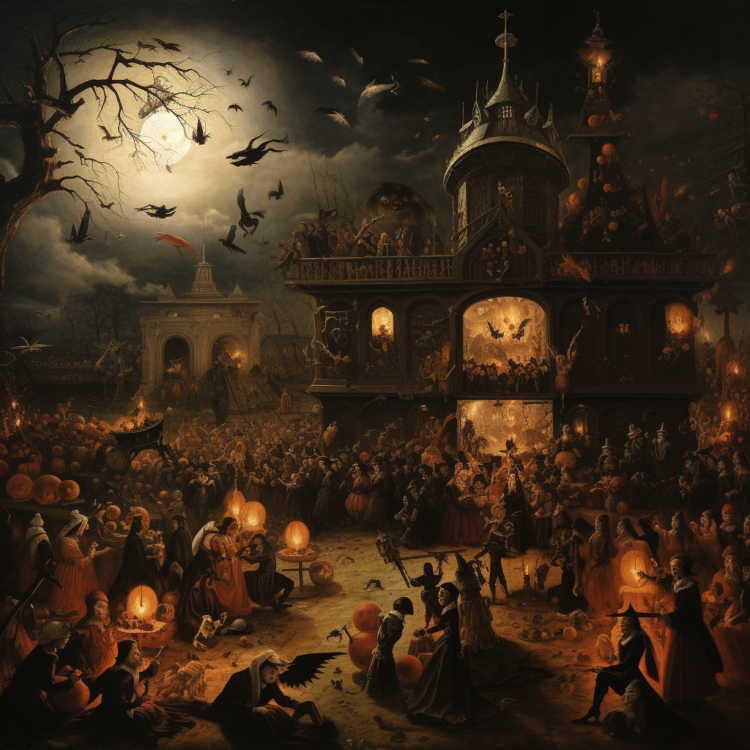
As modern pagans honor the energy of this liminal time, they engage in practices that hold profound spiritual significance, fostering connections with ancestors, spirits, and the natural world.
Halloween’s roots in ancient pagan traditions harken back to a time when the cycles of nature, the spirit realm, and human existence were intricately intertwined. Through the ages, Halloween evolved, merging with cultural and religious influences, yet retaining its essential connection to the mystical and spiritual.
In the modern pagan context, Halloween emerges as a time of multifaceted celebration.
It’s a season for delving into ancestral wisdom, engaging in practices of divination and spirit communication, and crafting rituals that resonate with the energy of the time.
It’s a moment to honor both the light and dark aspects of existence, acknowledging the rich lessons and insights that each facet offers.
It’s also an opportunity to reflect on our relationship with the Earth, fostering a deeper awareness of our role as stewards of the planet.
As modern pagans navigate this journey, Halloween becomes a prism through which they view the world – one that refracts the light of ancient traditions, the wisdom of the ancestors, and the transformative power of spiritual practices.
It is a time when the veil between realms is thin, allowing them to experience moments of profound connection, guidance, and transformation.
By embracing the essence of Halloween, modern pagans renew their commitment to living in harmony with the rhythms of nature, to nurturing their spiritual connections, and to honoring the legacy of those who came before.
Through their rituals, practices, and celebrations, they affirm the belief that the magic of the unseen world is woven into the fabric of their everyday lives.
In the end, modern pagan celebrations of Halloween invite us all to ponder the mysteries that lie beyond the veil, to acknowledge the interconnectedness of all things, and to embrace the journey of the soul in its eternal dance between the known and the unknown.
As we navigate the cycles of life, death, and rebirth, we find solace in the belief that Halloween serves as a time when the realms of the mundane and the mystical intertwine, reminding us of the wonder and enchantment that permeate our existence.
We certainly hope this has given you a broader understanding of what a modern Pagan Halloween is all about. By digging in a little deeper in Samhain traditions and practices, you will appreciate this honored and timeless celebration more.
If you would like to learn more about Pagan holidays, be sure to read our post on The Wheel of the Year, Pagan Holidays!
